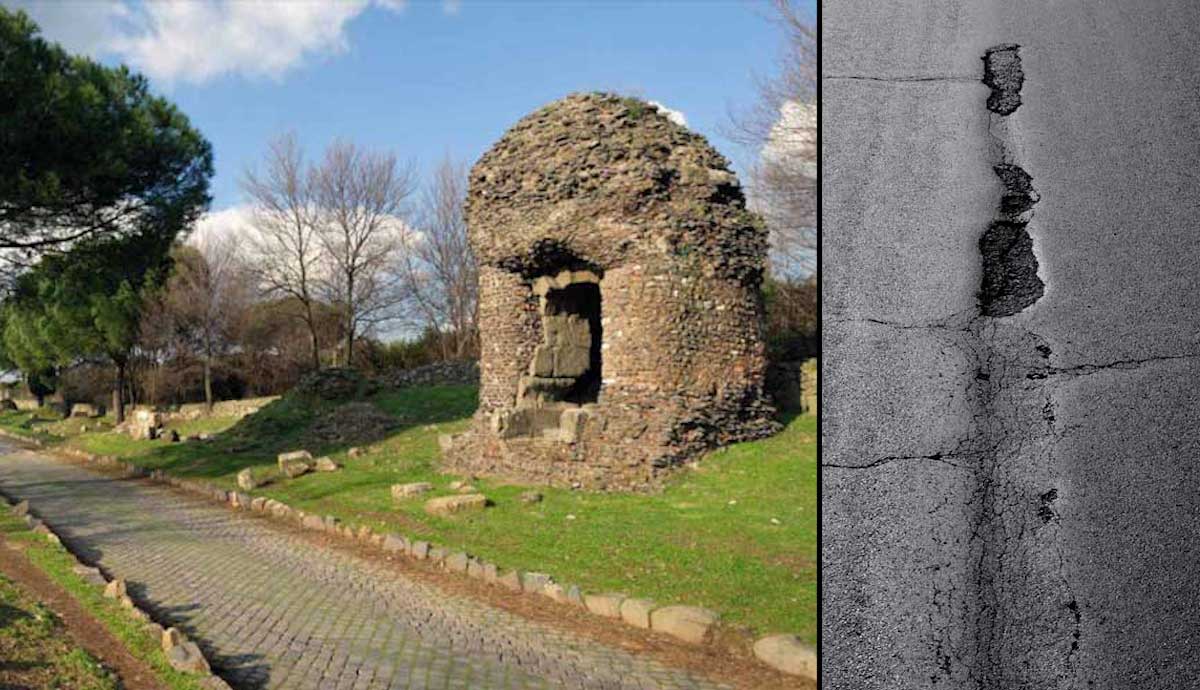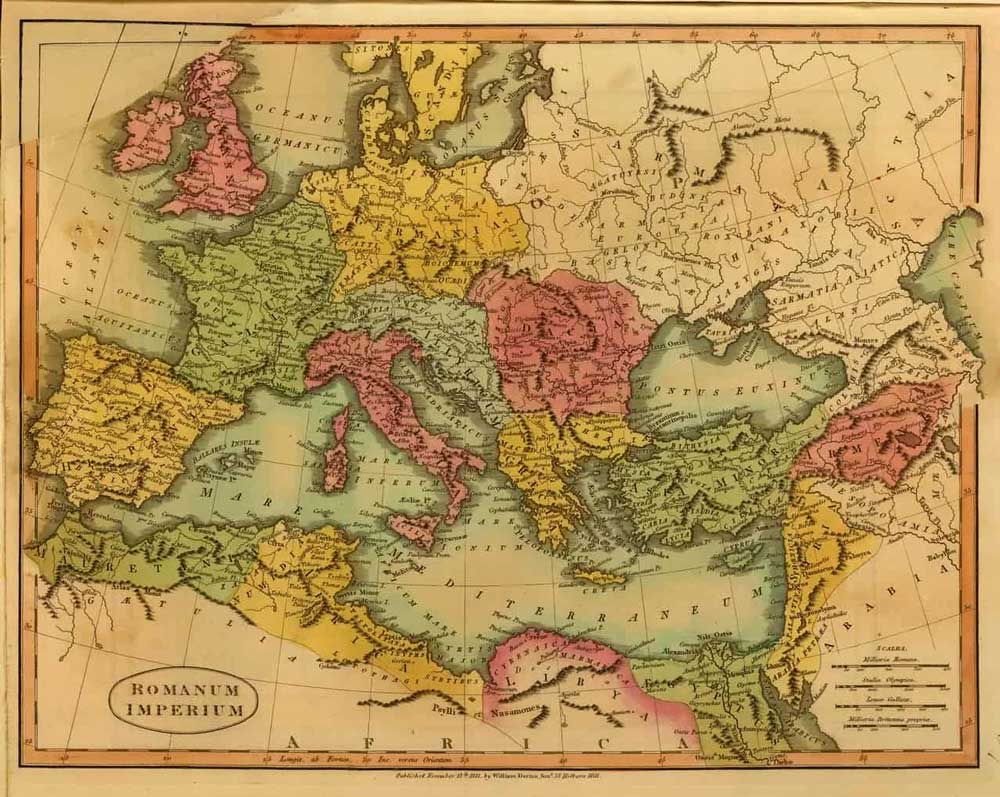
At its greatest extent, the Roman Empire encompassed a vast area from modern-day Portugal in the west to modern-day Iraq and the Caucasus Mountains to the east, from Egypt to its south all the way to England to its North. This expansive area was connected through an extensive roadway system. But if this was made in ancient times and was heavily used, why does it look like the famous Roman roads had no potholes, but our roads are full of them?
The Roman Transportation System and the Roman Roads

In the Roman Empire, truly all roads led to Rome since it was the capital. To sustain trade and the collection of taxes and manpower far away from the capital, the Romans needed a transportation system that could deliver both quantity and quality. As can be seen from the above image, the transportation layout of three Roman provinces — Italia, Iberia, and Britannia — appears like a modern-day interstate system. This map only includes three out of the numerous provinces held by the empire for hundreds of years. At a quick glance, the network of Britannia is a web of roads, a microcosm of the great inter-connectedness of Roman roads.

While the Romans did have such a great transportation system, they were not the first to create an extensive one. Two earlier examples include the Persian and the Macedonian Empires.
What is often forgotten is that the Romans did not rely only on overland travel for their transportation and logistical needs. They also recognized and used rivers and the sea as more inexpensive forms of transportation. Just as many major, powerful, and capital cities throughout history have been developed near a body of water, so was Rome. The eternal city was built on the Tiber River ford, which allowed inland travel.
Get the latest articles delivered to your inbox
Sign up to our Free Weekly Newsletter
How Were Roman Roads Made?

The roads themselves did vary in cross-section profiles and materials depending on the use and traffic density; the same with modern roads. Not all roads have to be interstates, and not all interstates should be private roads that lead to a single house, for example.
However, a general cross-section profile and some typically used materials have been found in common between many different Roman roads. A typical cross-section, and thus what the road is actually made of, contains a few layers stacked on top of each other. Usually, a hole would be dug up to around 5 feet deep for a very heavy-duty road, such as the Appian Way featured above. Then it often contains a small layer of sub-base which is compacted sand or dry earth. The next layer up would often contain a foot or two of crushed rock to provide support for the road. Else, the road would simply just sink into the ground due to heavy traffic until it either became too compacted to continue sinking or tear apart and then become useless.
The next layer up would often contain gravel in cement mortar. Then, above that would be cement with sand and gravel. This would actually be very similar to modern-day concrete, which is made up of essentially the same components. Then the top layer contains rocks or stone slabs. Simply by looking at this, it ought to provide a way for water to drain while keeping the top layer relatively water-free. Almost all Roman roads should have a drainage ditch parallel, or gutter, to its run. This can also be seen in the image above, with the brown path that runs in tandem with the road next to the outer-left edge of the road.

There is also the chance that modern-day bikers have used this path as a more enjoyable path to bike on than the road itself should they find it bumpy, yet that does not mean that the ditch on the Appian Way’s left will not work great as a drainage ditch once it rains.
One may go and walk the Appian Way today, which is astounding as it was built in 312 BCE by the censor Appius Claudius. The convention of naming roads after the censor who ordered their construction was a practice that applied to many other Roman roads. Appius ordered the project due to a logistical failure during the 2nd Samnite War in the 400s BCE. As the Romans were assisting the city of Capua in a war against the Samnites, the Roman legions were defeated since they lacked a sufficient water supply.
So, similar to the construction of the US Interstate Highway System, it provided significant military benefits. Yet, with the Appian Way being so old, it was only the beginning for the Roman road system to become one for the military, civilian, and economic benefit of the entirety of the Republic and then the Empire, just as today’s US Interstate System is.
The Construction of Modern Roads

Modern roads are significantly more impressive than Roman roads in abilities. As can be seen in this weave of roads hundreds of feet in the air in multiple places, this is a product of the modern world’s advancement in technology. There are no images of Roman roads weaving through and around each other and at such great heights. However, Roman aqueducts and their massive scale may be one of the few things that can rival the epic scale of this interchange. Still, modern roads, like the one in the photo, contain cars and semi-trailers driving at a high rate of speed, likely 70 miles per hour or more. The lack of engines alone during the Roman control of Europe simply shows such a disparity in the beatings a modern road takes compared to a heavy cart moving at the rate of a couple of horses.
So, is there a comparison to be made between modern and Roman roads? Of course, one is a predecessor to the other. Modern roads have similar cross-section profiles to Roman roads. They often contain a compacted subgrade, then a subbase course of crushed rocks, then a base course of gravel, then the asphalt pavement on top. There are also almost always drainage ditches on the sides of the pavement. Anyone can go out and see that there is a point called a “crown” in the center of the road. This is designed to push water away from the center and towards the ditch or even a storm sewer system.

So, since the United States Interstate Highway System is easy to compare to the Roman roads and transportation system, what is its history? The US Interstate System was part of the Federal-Aid Highway Act of 1956, signed by President Eisenhower, to fund the construction of the system. The FHWA notes that the Interstate System supported “civilian needs, economic development, highway safety, congestion relief, and motor vehicle-related lawsuits”. Additional major benefits of the system included use in evacuations and military transportation.
It should be noted that this may have been one of the largest contributors to the car-centric America of today, where it is sometimes impossible to travel across town by foot or bicycle. This begs the question of why the funding money was used for roads instead of public transit systems that would evolve like those of Europe and Japan. The FHWA state that this was not an option in 1955 and 1956, when the congressional debate regarding the Interstate System took place. The railways of America were owned mainly by private companies, and many still are today.
So, Did Roman Roads Not Have Potholes?

So, after all, why does it seem like Roman roads do not have any potholes and roads all over the Interstate do? Was Roman technology really that advanced? Did the Romans know something the modern world does not?
Quite frankly, no. They just lived in a different time. In 2014, archaeologists uncovered “wheel ruts” or potholes in Devon, United Kingdom, similar to wheel ruts found at Pompeii. Also, the American Journal of Archaeology found that over 400 spots of roads within Pompeii had evidence of road repairs. This means that potholes were certainly an issue for Roman roads, even if today, the roads appear infallible in construction.
The roads used today are the best and most well-preserved of Roman roads. Since they are the best, we assume that most Roman roads were like this. But this is survivorship bias. There may be a couple of American interstate roads 2000 years from now that survived due to maintenance and great preservation. The humans from 4000 CE would likely think the same thing about those roads as people do today about Roman roads.
Yet, there is one glaringly huge difference between Roman roads and modern roads that has only been alluded to so far. That difference is the traffic itself. Roman roads did not have to deal with cars and semi-trucks driving as fast as they do now. Cèsar Carreras & Pau De Soto state that a standard wagon would weigh around 3000 pounds and could travel around 10 miles a day at normal speed on plain terrain.
Meanwhile, modern cars weigh an average of 4000 pounds, and fully-loaded semi-trucks are over 20,000 pounds of weight! The average car alone weighs more than a fully loaded wagon! The average US interstate road allows 60 to 70 miles per hour. There are plenty of drivers who drive faster than that. Now, imagine a legion of 20,000-pound semi-trucks driving at 70 miles per hour over a road. If one compares that to a convoy of 3,000-pound wagons driving at 10 miles a day, it can easily be seen that Roman roads are not special compared to modern roads. Modern roads simply take a heavier beating and still provide a relatively reasonable and economical way to transport things across the world.
So do not fret too much about the potholes; it’s a problem as ancient as the Romans.







